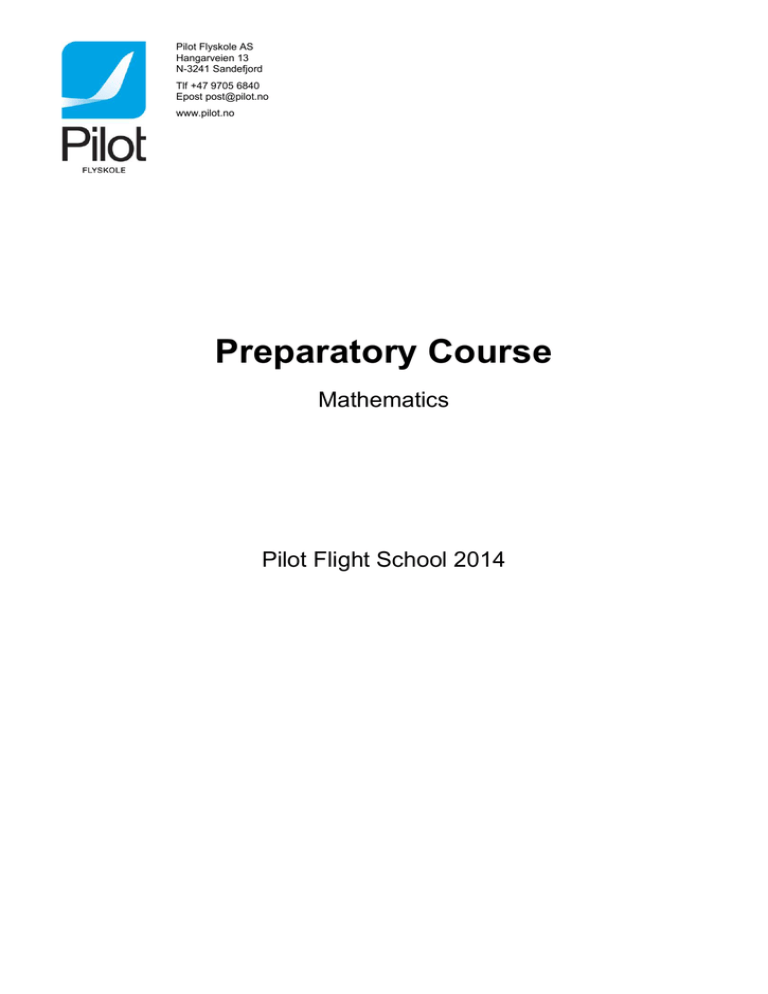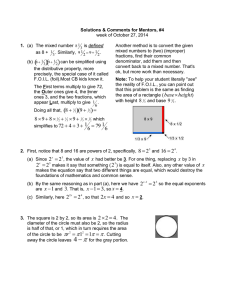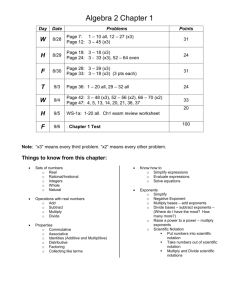Preparatory Course - Pilot Flight Academy
advertisement

Pilot Flyskole AS Hangarveien 13 N-3241 Sandefjord Tlf +47 9705 6840 Epost post@pilot.no www.pilot.no Preparatory Course Mathematics Pilot Flight School 2014 Order of operations Operations means things like add, subtract, multiply, divide, squatting etc. If it is not a number it is probably an operation. But when you see something like… 7 + (6 x 52 + 3) …what part should you calculate first? Start at the left and go to the right? Or go from right to left? If you calculate them in the wrong order, you will get a wrong answer! So, long ago people agreed to follow rules when doing calculations, and they are: 1) Do things in parentheses first: 6 × (5 + 3) = 6× 8 = 48 6 × (5 + 3) = 30 + 3 = 33 (wrong) 2) Exponents (i.e. powers, roots) before multiply, divide, add or subtract. Example: 5 × 22 = 5× 4 = 20 5 × 22 = 102 = 100 (wrong) 3) Multiply or divide before you add or subtract. Example: 2+ 5×3 = 2 + 15 = 17 2+5×3 = 7×3 = 21 (wrong) 4) Otherwise just go left to right 30 ÷ 5 × 3 = 6 ×3 = 18 30 ÷ 5 × 3 = 30 ÷ 15 = How do you remember it all? PEMDAS! P E MD AS Parentheses first Exponents Multiplication and Division Addition and Subtraction 2 (wrong) Example 1: How do you work out 3 + 6 x 2? Multiplication before addition: First 6 x 2 = 12, then 3 + 12 = 15 Example 2: How do you work out (3 + 6) x 2? Parentheses first: First (3 + 6) = 9, then 9 x 2 = 18 Example 3: How do you work out 7 + (6 x 52 + 3)? 7 + (6 x 52 + 3) 7 + (6 x 25 + 3) Start inside Parentheses, and then use Exponents first 7 + (150 + 3) Then Multiply 7 + (153) Then Add 7 + 153 Parentheses complete = 160 Done! Link to video: https://www.khanacademy.org/math/cc-seventh-grade-math/cc-7th-variables-expressions/cc7th-order-of-operations/v/introduction-to-order-of-operations Exponents The exponent of a number says how many times to use the number in a multiplication. In 82 the "2" says to use 8 twice in a multiplication, so 82 = 8 × 8 = 64 Examples: 53 = 5 × 5 × 5 = 125 24 = 2 × 2 × 2 × 2 = 16 Exponents make it easier to write and use many multiplications. Example: 96 is easier to write and read than 9 x 9 x 9 x 9 x 9 x 9. You can multiply any number by itself as many times as you want using exponents. What if the exponent is 1 or 0? - If the exponent is 1, then you just have the number itself (example 9 1 = 9) - If the exponent is 0, then you get 1 (example 90 = 1) Multiplication with exponents When multiplying two exponents with the same base number, just add the exponents. Example: 32 × 34 = 32+4 = 36 Division with exponents When dividing two exponents with the same base number, subtract the exponents. Example: 97 : 9 3 = 97-3 = 94 Add/subtract exponents with different base numbers If you got two exponents with different base number, you need to calculate each exponent before you add/subtract. Example: 23 + 4 2 = 2×2×2+4×4= 8 + 16 = 24 Link to video: https://www.khanacademy.org/math/cc-sixth-grade-math/cc-6th-arithmetic-operations/cc-6thexponents/v/introduction-to-exponents Fractions A fraction is a part of a whole. Slice a pizza, and you will have fractions: 1/ 1/ 2 (One-Half) 3/ 4 (One-Quarter) 8 (Three-Eighths) The top number tells how many slices you have, the bottom number tells how many slices the pizza was cut into. Some fractions may look different, but are really the same, for example: = 4/8 = 2/4 1/2 It is usually best to show an answer using the simplest fraction (1/2 in this case). That is called simplifying, or reducing the fraction. A fraction (such as 3/4) has two numbers: We call the top number the Numerator, it is the number of parts we have. We call the bottom number the Denominator, it is the number of parts the whole is divided into. Adding fractions: You can add fractions easily if the bottom number is the same: 1/ 1/ + 4 (One-Quarter) 4 (One-Quarter) + 2/ = 4 = (Two-Quarters) = 1/ 2 (One-Half) = Adding fractions with different denominators: What if the denominators (bottom numbers) are not the same? You cannot add fractions with different denominators. As in this example, you need to make the denominators the same: 1/ 1/ + = ? 3 6 What should be the new denominator? One simple answer is to multiply the current denominators together: 3 x 6 = 18 So, instead of having 3 or 6 slices, we will make both of them have 18 slices. 18 is a lot of slices. Can you do it with fewer slices? Here is how to find out: 1/ List the multiples of 3: 3 1/ List the multiples of 6: 6 3, 6, 9, 12, 15, 18, 21, ... 6, 12, 18, 24, ... Then find the smallest number that is the same Multiples of 3: 3, 6 , 9, 12, 15, 18, 21, ... Multiples of 6: 6 , 12, 18, 24, ... The answer is 6, and that is the least common denominator. So let us try using it! We want both to have 6 slices. When we multiply top and bottom of ⅓ by 2 we get 2/6. 1/6 already has a denominator of 6. And our question now looks like: /6 2 + /6 1 = Multiplication with fractions: (Multiply the tops, multiply the bottoms) Step 1: Multiply the top numbers (numerators) Step 2: Multiply the bottom numbers (denominators) Step 3: If needed, simplify Example 1: 1 1 1 2 2 4 Example 2: 1 3 3 5 7 35 /6 3 Division with fractions: When dividing fractions, Step 1: Turn the last fraction upside down (change numerator with denominator, it becomes reciprocal). Step 2: Multiply the first fraction by that reciprocal (multiply tops and bottoms) Example: 1 2 1 7 7 : 5 7 5 2 10 We leave the first fraction, while turning fraction number two. 2/7 becomes 7/2. Then multiply numerator with numerator and denominator and denominator. Another example: 7 3 7 2 14 : 9 2 9 3 27 Link to video: https://www.khanacademy.org/math/pre-algebra/fractions-pre-alg/understanding-fractions-prealg/v/introduction-to-fractions Equation What is an equation? An equation says that two things are equal. It will have an equals sign “=” like this: 7 + 2 = 10 – 1 That equation says: what is on the left (7 + 2) is equal to what is on the right (10 – 1) So, an equation is like a statement “this equals that”. To solve an equation, you apply inverses to each side of the equation until the variable you want to solve for is alone by itself on one side of the equation, and appears nowhere on the other side. What is an inverse? An inverse is an operation that 'undoes' another operation. Suppose you have something like: x + 5 = 10 The additive inverse of 5 is -5, so you can 'invert' the addition by adding -5: x + 5 + -5 = 10 + -5 x=5 If you have a problem like 7x – 10 = 3x + 6 you need to find X. This kind of equation is called a linear equation, and it usually has just one variable. We will walk you through the simple steps: 1) Check the equation for varying terms and constant terms. Varying terms are numbers like "7x" or "3x" or "6y" or "10z," where the number changes depending on what you plug into the variable, or letter. Constant terms are numbers like "10" or "6" or "30," where the number never changes. 2) Move the varying terms to one side of the equation. It doesn't matter to which side you move the varying terms. a. In this example, 7x - 10 = 3x - 6 can be rearranged by choosing to subtract either(7x) or (3x) from both sides. Choosing to subtract 7x, you have: (7x - 7x) - 10 = (3x - 7x) - 6. -10 = -4x - 6 3) Next, bring all the constant terms onto the other side of the equation. That is: move the constant terms so that they are on the opposite side of the equation from where the varying terms are. a. We see that -6 must be subtracted from both sides: -10 - (-6) = -4x - 6 - (-6). -4 = -4x 4) Lastly, to find the value of x, simply divide both sides by the coefficient of x. The coefficient of x (or y, or z, or any letter) is the number in front of the varying term. a. The coefficient of x in -4x is -4. So divide both sides by -4 to get the value of x = 1. b. Our answer to the equation 7x - 10 = 3x - 6 is x = 1. You can check this answer by plugging 1 back into every "x" variable and seeing if both sides of the equation equal the same number: 7(1) - 10 = 3(1) - 6 7 - 10 = 3 - 6 -3 = -3 Link to video: https://www.khanacademy.org/math/cc-eighth-grade-math/cc-8th-solving-equations/cc-8thequation-solutions/v/number-of-solutions-to-linear-equations Squares and Square Roots First learn about squares, then square roots are easy. To square a number, just multiply it by itself… Example: What is 3 squared? 3 squared = 3 x 3 = 9 Squared is often written as a little 2 like this: This says "4 Squared equals 16" (the little 2 says the number appears twice in multiplying). We can also square negative numbers. What happens when we square (-5)? (-5) x (-5) = 25 (negative times a negative gives positive) Square roots: A square root goes the other way: 3 squared is 9, so square root of 9 is 3 A square root of a number is a value that can be multiplied by itself to give the original number. A square root of 9 is…. ….3, because when 3 is multiplied by itself we get 9. It is like asking: What can we multiply by itself to get this? Calculating square roots It is easy to work out the square root of a perfect square, but it is hard to work out other square roots. Example: What is √10? Well, we know that 3 x 3 = 9 and 4 x 4 = 16, so we can guess the answer is between 3 and 4. Let’s try 3,5: Let’s try 3,2: Let’s try 3,1: 3,5 x 3,5 = 12,25 (too high) 3,2 x 3,2 = 10,24 (slightly high) 3,1 x 3,1 = 9,61 (slightly low) Getting closer to 10, but it will take a long time to get the correct answer. In the admission tests 3,2 or 3,1 is good enough, but out of a calculator you’ll get 3,16227….. So even the calculator’s answer is only an approximation! Algebra Algebra (meaning “reunion of broken parts) is one of the broad parts of mathematics, together with number theory, geometry and analysis. Algebra is the study of symbols and the rules for manipulating symbols and is a unifying thread of all of mathematics. We’re going to make this part as easy as possible. We’ll now have a look at how to evaluate expressions. Algebraic expressions may be evaluated and simplified, based on the basic properties of arithmetic operations (addition, subtraction, multiplication and so on). Here are some rules: - - Added terms are simplified using coefficients. = 3x (where 3 is the coefficient) Multiplied terms are simplified using exponents. is represented as x3 Similar terms are added together. For example: o 2x2 + 3ab – x2 + ab is written as x2 + 4ab, because the terms containing x2 are added together, and, the terms containing ab are added together. o 2x2 - x2 = x2 and 3ab + ab = 4ab. Brackets can be “multiplied out”. For example: o x(2x + 3) can be written as (x × 2x) + (x × 3) which can be written as 2x2 + 3x Some examples: a) 4a – 2a = 2a b) 5b – b = 4b c) a + 4a – 2a = 3a d) 2a – 3b + 5a – 3a + 7b = 2a + 5a – 3a – 3b + 7b = 4a + 4b e) 2ab – 13d – 5ba + 24d= 2ab – 5ba – 13d + 24d= -3ab + 11d Pythagoras’ Theorem Over 2000 years ago, there was an amazing discovery about triangles: When the triangle has a right angle (90 degrees), and squares are made on each of the three sides, then the biggest square has the exact same area as the other two squares put together! It’s called “Pythagoras’ Theorem” and can be written in one short equation: a2 + b2 = c2 Note: - c is the longest side of the triangle a and b are the other two sides Definition The longest side of the triangle is called the “hypotenuse”, so the formal definition is: In a right angled triangle: The square of the hypotenuse is equal to the sum of the squares of the other two sides. Let’s see if it really works using an example: A “3,4,5” triangle has a right angle in it. 32 + 4 2 = 52 3×3=9 4 × 4 = 16 9 + 16 = 25 So why is this useful? If we know the lengths of two sides of a right angled triangle, we can find the length of the third side. (Remember it only works on right angled triangles!) How do we use it? Write it down as an equation: a 2 + b 2 = c2 Now you can use algebra to find any missing value, as in the following examples: Example 1, solve this triangle. a 2 + b 2 = c2 52 + 122 = c2 25 + 144 = c2 169 = c2 c2 = 169 c = √169 c = 13 Example 2, solve this triangle. a 2 + b 2 = c2 92 + b2 = 152 81 + b2 = 225 Take 81 from both sides: b2 = 144 b = √144 b = 12 Surface area and circumference What is area? Area is the size of a surface! These shapes all have the same area of 9: It helps to imagine how much paint would cover the shape. There are special formulas for certain shapes, as you can see above. Example: What is the area of this rectangle? The formula is: Area = w × h w = width h = height The width is 5, and the height is 3, so we know w = 5 and h = 3 Area = 5 × 3 = 15 Example: The circle has a radius of 2,1 meters: The formula is: Area = π × r2 Π = the number pi (3,14) R = radius The radius is 2,1 m, so: Area = 3,14 × (2,1m)2 = 3,14 × (2,1m x 2,1m) = 13,8544…m2 Example 1: Given the rectangle ABCD below. a) Calculate the surface area of the rectangle. Surface area 6 m 2 m=12 m 2 b) Calculate the length of the diagonal AC. Use Pythagoras sentence to find the diagonal. AC 2 62 22 AC 2 36 4 AC 2 40 AC 40 AC 6,3 Diagonal AC is about 6,3 meters c) Calculate the surface area of the triangle ABC 6,0 m 2,0 m 12,0 m2 6,0 m2 Surface area of ABC 2 2 Example 2: Calculate the surface area of the circle below. Surface area of the circle r 3,0 cm 28,3 cm 2 2 2 Example 3: A square with lengths 10,0 cm. Calculate the surface area of the square All sides in a square have the same lengths. Surface area of the square: 10,0cm × 10,0cm = 100 cm2


